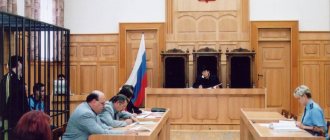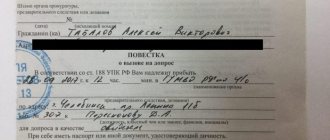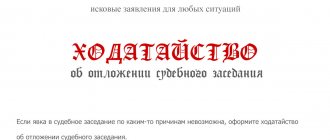The protocol of a court hearing in a criminal case is an integral element of criminal procedural legislation. It is compiled and filled out by the secretary directly in the courtroom. The minutes set out all the events that took place during the meeting. This document guarantees strict compliance with all legal rules of the judicial process, and also allows you to subsequently verify the legality of the final decision made by the court. The rules and conditions for implementing the protocol can be found in Article 259 of the Criminal Procedure Code of the Russian Federation.
Multi-channel free hotline Legal advice on criminal law. Every day from 9.00 to 21.00
Moscow and region: +7 (495) 662-44-36
St. Petersburg: +7 (812) 449-43-40
Article 259 of the Code of Criminal Procedure of the Russian Federation
Not a single court hearing in a criminal case can be recognized as valid without a protocol. This document is necessary to ensure that hearings on the case take place legally and in compliance with all norms of criminal procedural legislation. It fully reflects the scenario of the trial, including all the nuances and events that took place in the courtroom. Forms and samples of the protocol can be found freely available on the Internet.
This document is executed in printed or written form by a secretary who is in the courtroom and records all the actions of the parties to the trial and the court decision. When a case is submitted to the office, the presence of a protocol in it is a prerequisite.
The protocol can act as evidence provided that all norms and rules for its implementation are observed. This rule is regulated by Article 83 of the Code of Criminal Procedure of the Russian Federation.
A very common problem that arises during litigation is the possible presence of subjective information in a given document. All circumstances related to the investigation of the case and trial depend on the quality of the protocol. The protocol should in no case distort the available data, since this is the only document that reflects the entire essence of any trial in a criminal case. In some cases, distortion of data may call into question the legality of the protocol, and therefore the entire meeting.
All information recorded in the protocol is a reflection of the actions and decisions of the judge who is trying a particular criminal case.
This document must contain the following information:
- place of trial;
- date of its holding;
- type of meeting (open or closed);
- a brief description of the case under consideration (any criminal act, such as theft, robbery, murder, etc., as well as brief preliminary information about the circumstances of the offense);
- information about the defendant (full name, date of birth);
- information about the persons present in the courtroom (secretary, judge, prosecution, defense attorney, victims, witnesses, interpreter, plaintiff, defendant, police);
- a detailed and consistent description of the actions that took place in the courtroom;
- all motions and statements made during the trial;
- all rulings and decisions rendered by the judge and jury;
- all situations related to clarification of the rights and obligations of participants in the trial (witnesses, parties, etc.);
- details and details of all testimony that took place during the hearing;
- all questions asked by the judge and the parties to the trial;
- responses from witnesses, victims and suspects;
- information about inspections and consideration of evidence that took place directly during the trial;
- new circumstances in the case under consideration, which must be included in the protocol at the request of one of the parties to the trial;
- information about the speech of both sides during the debate;
- the last word of the defendant or a note about the refusal of the last word;
- the announced verdict (detention, correctional labor, reversal of the sentence, etc.) and other court decisions (payment of alimony, correctional labor, etc.);
- the preventive measure chosen by the court in relation to the defendant;
- information on clarification of the rights of the defendant and the parties to the hearing regarding appealing the verdict and filing appeals.
Thus, the record of the case is a detailed and detailed retelling of all the events that occurred during the proceedings.
This document allows you to recreate the overall picture of the entire process from its beginning to completion.
Sometimes photography and video recording are used during the meeting. In such cases, a note about this must be made in the protocol. In addition, it is necessary to note cases in which the entire process was broadcast on television, radio or on the Internet. All materials are attached to the case file. In the case of broadcasting, the protocol indicates the source in which it was carried out (name of television channel, radio station, Internet site).
Within three days from the end of the meeting, the protocol on the criminal case is signed by two persons:
- Secretary.
- The presiding judge.
Without these signatures, the protocol is not valid.
It is important to note that the protocol can be drawn up in full, or it can be prepared in parts. As a rule, this happens because several court hearings were held during the investigation of a criminal case. In accordance with the requirements of the Code of Criminal Procedure of the Russian Federation, the court is not required to draw up a separate protocol for each meeting held. Each part of the document is signed by the above persons, after which it receives legal force.
The parties to the meeting have the right to familiarize themselves with the minutes. Within three days from the date of completion, any of the parties may submit a written request to familiarize themselves with the data of the protocol.
Most often, such requests are approved. However, there are cases in which an application may be denied:
- if the case under consideration is sent to the appellate court;
- if the period during which the parties can submit an application to study the protocol information has expired (3 days);
- if the period during which it is possible to file an appeal in this criminal case has expired.
After approval of the petition, representatives of the parties have three days to familiarize themselves with the information in the protocol from the moment they receive the petition.
However, not only the parties to the trial have the right to familiarize themselves with the protocol. Any participant in the meeting (a witness in the case, a victim, etc.) has the right to familiarize himself with the text of the document, namely the section in which their testimony is stated.
In special cases, the preparation and proper execution of a protocol requires a period of more than three days. In this case, in accordance with the law, all parties and participants in the proceedings who requested to familiarize themselves with the protocol must be notified of the date of signing and entry into force of this document, after which they will have the right to familiarize themselves with it.
The time allotted for familiarization with the protocol depends on its volume: as a rule, it is at least five days. In some cases, this time may be extended for a certain period. Setting deadlines for familiarization is the responsibility of the presiding judge.
In addition, the parties and participants in the process may request the production of a copy of the protocol. At the same time, its certification and other necessary procedures are carried out at the expense of the applicant party.
Thus, the record of a court hearing in a criminal case is a document that is truly necessary in any criminal proceeding. The legality of the decision made by the court in criminal cases, as well as the decision of the arbitration or cassation courts, which may take part in a particular trial, depends on how correctly it is drawn up.
Everything about criminal cases
Go to the text of the Code of Criminal Procedure
Url Additional information:
Protocol of the court session
- part 1 259 of the Code of Criminal Procedure
obligation to keep minutes during a court hearing
- part 1 259 of the Code of Criminal Procedure
audio recording in the first and appellate instances
- part 1 259 of the Code of Criminal Procedure
No audio recording is taken during a closed meeting
- Part 2 259 Code of Criminal Procedure
can be made by hand, typewriter, computer
- Part 2 259 Code of Criminal Procedure
shorthand and technical means may be used
Contents of the protocol
- Part 3 259 Code of Criminal Procedure
contents of the protocol:
— clause 1, part 3, 259 Code of Criminal Procedure
place of meeting
— clause 1, part 3, 259 Code of Criminal Procedure
meeting date,
— Clause 1 Part 3 259 Code of Criminal Procedure
its start and end time
— clause 2, part 3, 259 Code of Criminal Procedure
what criminal case is being considered
— clause 3, part 3, 259 Code of Criminal Procedure
composition of the court and participants
— clause 4, part 3, 259 Code of Criminal Procedure
information about the identity of the defendant
— clause 5, part 3, 259 Code of Criminal Procedure
actions of the court, in the order in which they took place
Petitions from participants
— clause 6, part 3, 259 Code of Criminal Procedure
the minutes indicate statements, objections and petitions
— clause 7, part 3, 259 Code of Criminal Procedure
decisions made without removal to the deliberation room
— clause 8, part 3, 259 Code of Criminal Procedure
decisions made with removal to the deliberation room
— clause 9, part 3, 259 Code of Criminal Procedure
information on explaining to participants the rights and responsibilities
Testimony of those interrogated
— clause 10, part 3, 259 Code of Criminal Procedure
detailed content of testimony
- clause 11 part 3 259 Code of Criminal Procedure
questions asked to the interrogated and their answers
- clause 12 part 3 259 Code of Criminal Procedure
results of evidence investigation activities
— clause 13, part 3, 259 Code of Criminal Procedure
circumstances that participants ask to be recorded in the protocol
- clause 14 part 3 259 Code of Criminal Procedure
content of speeches in the debate and the last word
— clause 15, part 3, 259 Code of Criminal Procedure
information on explaining the procedure for familiarizing yourself with the protocol
— clause 16, part 3, 259 Code of Criminal Procedure
information on clarification of the appeal procedure
- Part 4 259 Code of Criminal Procedure
on measures of influence in case of violation of order at a meeting
- Part 5 259 Code of Criminal Procedure
a note about the photos, audio, video recordings taken
Preparation of the protocol
- Part 6 259 Code of Criminal Procedure
The protocol is prepared and signed within 3 days
- Part 6 259 Code of Criminal Procedure
signed by the chairman and secretary
- Part 6 259 Code of Criminal Procedure
the protocol can be prepared in parts
Familiarization with the protocol
- Part 7 259 Code of Criminal Procedure
request for familiarization within 3 days after the meeting
- Part 7 259 Code of Criminal Procedure
if it is made later than 3 days, then the date of readiness is notified
- Part 7 259 Code of Criminal Procedure
familiarization within 3 days from receipt of the application
- Part 7 259 Code of Criminal Procedure
familiarization time is at least 5 days
When familiarization is not carried out
- Part 7 259 Code of Criminal Procedure
after sending to appeal
- Part 7 259 Code of Criminal Procedure
after the expiration of the appeal period
- Part 8 259 Code of Criminal Procedure
a copy of the protocol upon request, at your own expense
SELECTION OF MATERIALS
Trial protocol
meetings, selection of practical materials
BOOK - MANUAL
Verification algorithm
protocol of a court session: a manual for practitioners
Article 259 of the Code of Criminal Procedure. Protocol of the court session
Url Additional information:
— clause 11 part 2 389.17 Code of Criminal Procedure
there is no minutes of the meeting, cancellation on appeal
- paragraph 20
Plenum No. 19, the absence of a protocol distorts the essence of justice
1)
During each court hearing, minutes are kept.
Url Additional information:
FROM THE BOOK “Protocol Verification Algorithm”«
Audio recording of the protocol
— consequences of errors in the protocol (
Part 1 259 of the Code of Criminal Procedure
)
During the court hearing of the courts of first and appellate
instances, a protocol is drawn up in writing and recording is carried out using audio recording devices (audio recording).
When considering a criminal case in a closed court session in the cases provided for in Article 241 of the Code of Criminal Procedure, the use of audio recording devices is not permitted.
During the court hearing, a protocol is kept.
2) The protocol can be:
- written by hand,
- or typed,
- or made using a computer.
To ensure the completeness of the protocol when maintaining it, shorthand recording, as well as technical means, can be used.
Url Additional information:
FROM THE BOOK “Protocol Verification Algorithm”«
Errors in individual
details (
Part 3 259 of the Code of Criminal Procedure
) - consequences of errors
3) The minutes of the court session must indicate:
Url Additional information:
FROM THE BOOK “Protocol Verification Algorithm”
Place of meeting
- consequences of errors in the minutes of the meeting (
clause 1, part 3, 259 Code of Criminal Procedure
)
1). place
Url Additional information:
FROM THE BOOK “Protocol Verification Algorithm”
Meeting date
- consequences of errors in the minutes of the meeting (
clause 1, part 3, 259 Code of Criminal Procedure
)
and the date of the meeting,
Url Additional information:
FROM THE BOOK “Protocol Verification Algorithm”
Start time
and the end of the meeting - the consequences of errors (
clause 1, part 3, 259 Code of Criminal Procedure
)
its start and end time;
Url Additional information:
FROM THE BOOK “Protocol Verification Algorithm”
Information about the subject
in fact - the consequences of errors (
clause 2, part 3, 259 Code of Criminal Procedure
)
2). what criminal case is being considered;
Url Additional information:
FROM THE BOOK “Protocol Verification Algorithm”«
Name and composition
court, participants - consequences of mistakes (
clause 3, part 3, 259 Code of Criminal Procedure
)
3). name and composition of the court, information about the assistant judge, secretary, translator, prosecutor, defense attorney, defendant, as well as the victim, civil plaintiff, civil defendant, their representatives and other persons summoned to court;
Url Additional information:
FROM THE BOOK “Protocol Verification Algorithm”«
Personal data
defendant - consequences of mistakes (
clause 4, part 3, 259 Code of Criminal Procedure
)
4).
information about the identity of the defendant and the measure of restraint chosen against him;
5). actions of the court in the order in which they took place during the trial;
Url Additional information:
- Part 3 243 Code of Criminal Procedure
objections to the actions of the presiding officer, in the minutes
Oral and written requests
- Part 1 120 Code of Criminal Procedure
an oral petition is entered into the minutes
- Part 1 120 Code of Criminal Procedure
a written petition is attached to the criminal case
Oral petition
Oral petition
, there is a risk that it will be “lost” and how to avoid this
6). statements, objections and petitions of persons participating in the criminal case;
Url Additional information:
- Part 2 256 Code of Criminal Procedure
decisions made without going to the deliberation room
- part 1 256 of the Code of Criminal Procedure
the court is obliged to announce its decisions on petitions
7). rulings or rulings made by the court without going to the deliberation room;
Url Additional information:
- Part 2 256 Code of Criminal Procedure
decisions made only in the deliberation room
8). rulings or decisions made by the court with removal to the deliberation room;
Url Additional information:
- Part 1 11 Code of Criminal Procedure
participants in the process must be explained their rights
- Part 2 16 Code of Criminal Procedure
the accused is obliged to explain his rights
- Part 5 164 Code of Criminal Procedure
clarification of the rights of participants during each investigative action
- Part 10 166 Code of Criminal Procedure
the protocols must contain a record of clarification of rights
— 267 Code of Criminal Procedure
the judge is obliged to explain to the defendant his rights (
Part 4 47 of the Code of Criminal Procedure
)
— clause 9, part 3, 259 Code of Criminal Procedure
indication in the protocol of clarification of rights to participants
— clause 3
Plenum No. 29 explaining the rights of the accused at all stages of the process
Practice
— Determination No. APU-17
one of the rights is not explained (violation of
Part 2 16 of the Code of Criminal Procedure
)
Clarification of rights
Clarification of rights
participants in criminal proceedings, selection of materials
9).
information on explaining to participants in criminal proceedings their rights, duties and responsibilities;
Url Additional information:
FROM THE BOOK “Protocol Verification Algorithm”«
Interrogations and announcement
testimony - consequences of errors (
clause 10, part 3, 259 Code of Criminal Procedure
)
10). detailed content of the testimony;
eleven). questions asked to the interrogated and their answers;
Url Additional information:
- part 1 240 of the Code of Criminal Procedure
evidence is subject to direct examination
— clause 4
Plenum No. 55 cannot be referenced if it is not reflected in the protocol
FROM THE BOOK “Protocol Verification Algorithm”«
Research of written
evidence - errors (
clause 12, part 3, 259 Code of Criminal Procedure
)
12). the results of inspections and other research activities carried out at the court hearing; evidence;
13). circumstances that participants in criminal proceedings ask to be included in the protocol;
Url Additional information:
PRACTICE
Determination No. APU-17
no indication of refusal to debate (violation of
clause 14, part 3
)
Debate in the minutes
Reflection in the protocol
speeches of the defendant in the debate (
clause 14, part 3, 259 of the Code of Criminal Procedure
)
FROM THE BOOK “Protocol Verification Algorithm”«
Debate and last
word - consequences of errors in the protocol (
clause 14, part 3, 259 Code of Criminal Procedure
)
14).
the main content of the speeches of the parties in the judicial debate and the last word of the defendant;
Url Additional information:
Practical aspects
Announcement of the verdict
, procedure and registration
15). information about the announcement of the verdict
Url Additional information:
- Part 7 259 Code of Criminal Procedure
procedure for familiarizing yourself with the minutes of the meeting
and an explanation of
the procedure for familiarizing yourself with the minutes of the court session
Url Additional information:
— 260 Criminal Procedure Code
comments on the minutes of the court session
and bringing comments on it;
16). information on explanations to those acquitted and convicted:
Url Additional information:
- Part 3 309 Code of Criminal Procedure
clarification in the verdict on the procedure and deadlines for appeal
— 389.3 Code of Criminal Procedure
procedure for filing an appeal
— the procedure for appealing a verdict;
Url Additional information:
— 389.4 Code of Criminal Procedure
deadlines for appealing a verdict in an appeal
—
period for appealing the verdict,
Url Additional information:
- Part 3 309 Code of Criminal Procedure
clarification in the judgment about the right to apply for participation
— Part 3 389.6 Code of Criminal Procedure
petition - for participation in the consideration of the complaint
— as well as clarification of the right to petition for participation in the consideration of a criminal case by an appellate court.
Url Additional information:
- part 1 258 of the Code of Criminal Procedure
list of measures in case of violation of order
4) The protocol also indicates the measures taken against the person who violated order at the court hearing.
Url Additional information:
- paragraph 18
Plenum No. 35 entry is a recommendation, but not an obligation
5) If during the trial photography, audio and (or) video recording, filming of interrogations, broadcast on radio, television or on the Internet were carried out, then a note about this is made in the minutes of the court session.
Url Additional information:
— Note: this paragraph of the article refers to materials filmed at the initiative of the court. If the materials (photos, videos, etc.) were taken by other participants in the process, then for the disposal of them, see here: p.
Plenum No. 35.
In this case, photographic materials, audio and (or) video recordings, and filming are attached to the materials of the criminal case.
When broadcasting a court session, the minutes of the court session also indicate the name of the media outlet or website on the Internet through which the broadcast was carried out.
Url Additional information:
FROM THE BOOK “Protocol Verification Algorithm”«
Protocol form
and its signing - the consequences of errors (
Part 6 259 of the Code of Criminal Procedure
)
6) Within 3 days from the end of the court hearing, the protocol must be:
Url Additional information:
PRACTICE
Determination No. APU-17
parts of the protocol were not signed, the verdict was overturned
- prepared and signed by the presiding officer and the secretary of the court session,
and if the presiding officer has entrusted the keeping of minutes to the assistant judge, by the presiding officer and the assistant judge.
Url Additional information:
Parts of the protocol
Protocol in parts,
rights of protection when preparing the protocol in parts
The protocol during the court session can be prepared in parts,
Url Additional information:
— Determination No. APU-17
parts of the protocol are not signed, violation
which, like the protocol as a whole, are signed by the presiding officer and the secretary, and if the presiding officer entrusts the keeping of the protocol to an assistant judge, by the presiding officer and the assistant judge.
Url Additional information:
Familiarization
No right
familiarization with parts of the protocol, this cannot be required
At the request of the parties, they may be given the opportunity to familiarize themselves with parts of the protocol as they are prepared.
7) A request to familiarize yourself with the protocol and audio recording of the court session is submitted by the parties in writing within 3 days from the date of the end of the court session.
Url Additional information:
— P.
Plenum No. 51 petition to restore the comment period
- clause 3.2
Resolution No. 21-P restoration of the term for good reasons
This period may be restored if the application was not submitted for valid reasons.
The petition is not subject to satisfaction if the criminal case:
- has already been sent to the appellate court,
Url Additional information:
- part 2 393 of the Code of Criminal Procedure
sending the sentence to the body executing the punishment
- or after the expiration of the period provided for the appeal, is in the execution stage
.
Url Additional information:
— clause 7
Plenum No. 26 in the appeal will check whether they were familiar with the protocol
The presiding officer provides the parties with the opportunity to familiarize themselves with the protocol and audio recording of the court session within 3 days from the date of receipt of the petition.
The presiding officer has the right to provide the opportunity to familiarize himself with the protocol, audio recording and other participants in the trial at their request and insofar as it relates to their testimony.
If, due to objective circumstances, the protocol of the court session was prepared after 3 days from the date of the end of the court session, then the participants in the trial who filed petitions must be notified of the date of signing the protocol and the time when they can familiarize themselves with it.
The time for familiarization with the protocol of the court hearing and the audio recording is set by the presiding officer depending on the volume of the specified protocol, audio recording, but cannot be less than 5 days from the moment the familiarization begins. In exceptional cases, the presiding officer, at the request of the person familiarizing himself with the protocol, may extend the established time by audio recording. If a participant in the trial clearly delays the time of familiarizing himself with the protocol, the audio recording, the presiding officer has the right, by his decision, to set a certain period for familiarizing himself with them.
Return to the text of the Code of Criminal Procedure
Seek advice
Commentary on Article 259 of the Code of Criminal Procedure of the Russian Federation
Commentary to Art. 259 of the Code of Criminal Procedure of the Russian Federation explains the basic concepts of the article, which relate to:
- Conditions for appealing a court decision.
- Responsibility for drawing up the protocol.
- Data that is required to be entered.
In accordance with Article 85 of the Code of Criminal Procedure of the Russian Federation, the protocol of the court hearing in the case can be official evidence in this case.
If the need for an appeal arises, the parties and participants in the process will first refer to this document. It can be sent to any higher authority to clarify the circumstances and consider the appeal filed. The protocol can be completed either in writing or using technical means, for example, a computer. Sometimes shorthand is used to compile a document, and the deciphered transcript is not attached to the file.
All the parameters mentioned earlier, including the location of the meeting (city, region, district), date (day, month, year) and its participants, are necessarily recorded in the minutes.
In accordance with Article 245 of the Code of Criminal Procedure of the Russian Federation and the commentary attached to it, all responsibility for the correctness of drawing up this act lies with the secretary.
Each participant in the trial, including witnesses and victims, has the right to become familiar with the text of the document within five days from the date of its final execution. Responsibility for providing the parties and participants of the meeting with their rights lies with the presiding officer.
The judicial process will be declared illegal and untenable if the protocol is drawn up carelessly, illiterately, and also if important facts, additions and actions were omitted during its preparation. Filling out documents is the responsibility of the secretary.
Depending on the specific criminal case, there may be some changes in the court proceedings, which, accordingly, affect the protocol itself. The deadline for completing the protocol may be delayed under certain circumstances. In such cases, responsibility lies with the presiding judge.
The protocol is necessary in criminal law. It is worth noting that, for example, in the procedure for conducting administrative proceedings, a protocol is not drawn up, since the level of responsibility of the decision made by the judge in such cases is much lower.








